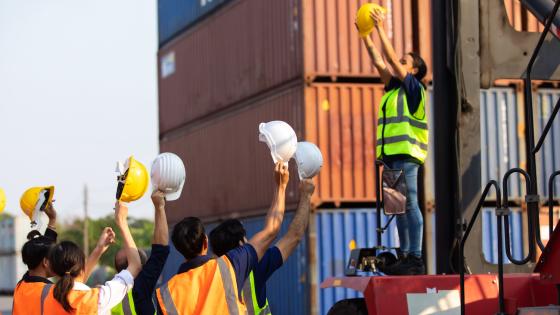After decades of post-imperial stagnation, South Asia has experienced impressive growth in recent years. From 1990 to 2005, the region’s GDP grew at about 6% annually – nearly twice the rate of the world economy. This acceleration in output growth took place in the context of a parallel increase in international trade – itself driven by a combination of declining trade barriers and transportation costs as well as technological changes. Between 1990 and 2005, South Asia’s largest economy, India (accounting for nearly 75% of regional GDP), more than doubled its trade to GDP ratio (from about 15% to 35%). Other countries in the region, including Bangladesh and Sri Lanka, also experienced impressive increases in their international trade.
Greater international trade in the region, however, has raised some basic questions regarding the gains from trade:
- Who benefits from trade?
- Will greater international trade result in an increase in income inequality and poverty?
- Should we expect the benefits from trade to be uniformly distributed across lagging and leading regions within a country (World Development Report 2009)?
Classic international trade theory predicts that trade will increase the returns to the abundant factors in an economy. For the unskilled-labour-abundant countries of South Asia, this is good news – the implication is that trade will raise the incomes of low-skilled workers, thus generating a reduction in poverty. It is, however, often argued that the benefits of trade may not spread uniformly across different regions within a country for a number of practical reasons.
- First, different regions may have different levels of access to international trade – lagging regions may not benefit from trade because transportation and other trade costs may be too high for these regions to interact with international markets.
- Second, an important source of the gains from trade is the improvement in the allocation of productive resources in the economy. To achieve this improvement in production efficiency, however, it is important that factors of production, such as labour, are mobile and that labour markets are flexible to enable mobility.
- Third, recent insights from the literature on the “new economic geography” suggest that increases in regional disparities may be a natural feature of the economic development process. Trade liberalisation may lead to an increase in the geographic concentration of economic activity – thus, possibly increasing (or decreasing) the extent of regional differences within a country.
Trade liberalisation and lagging regions
In recent research (Krishna et al. 2010), we have studied the unequal effects of trade liberalisation on poverty reduction across different sub-national regions within the developing nations of South Asia, with particular emphasis on India. According to a classification based on per capita GDP, now in use by the World Bank, the “lagging” regions within India include: Arunachal Pradesh, Assam, Bihar, Chattisgarh, Jharkhand, Madhya Pradesh, Manipur, Meghalaya, Mizoram, Nagaland, Orissa, Rajasthan, Tripura, Uttar Pradesh, Uttarkand, Tripura and the leading regions include the Andaman & Nicobar Islands, Andhra Pradesh, Chandigarh, Delhi, Goa, Gujarat, Haryana, Himachal Pradesh, Karnataka, Kerala, Maharashtra, Pondicherry, Punjab, Sikkim, Tamil Nadu.
The lagging states in India are farther away from ports (on average about 25% further from the nearest port than an average leading state). For example, the northeastern states in India that fall in the “lagging category” are somewhat geographically isolated. This isolation from the rest of India is accentuated by the intermediate presence of Bangladesh, which makes distance by road to the nearest port quite large (more than 700 miles in some instances). Also, the quality of roads and highway connections in this area lag behind most states. In contrast, Maharashtra is a leading state and itself has the country’s largest port, the city of Mumbai.
We examine the association between poverty reduction and trade liberalisation over the 1987-2000 period in lagging and leading states. For this exercise, we use state level measures of poverty rates constructed using household survey data collected by the National Sample Survey Organisation in India and state level measures of trade exposure constructed by weighting national trade barriers by state level employment shares in different manufacturing industries. Our analysis suggests that while poverty fell in India over this time period, trade liberalisation is associated with increases in poverty rates (relative to the mean rate of overall poverty reduction) in lagging regions. Specifically, in lagging regions, a percentage point reduction in the tariff rate is associated with a 0.8% increase in the poverty rate (relative to the mean rate of poverty reduction overall). Furthermore, this was true to a greater extent in rural areas than in the urban areas in lagging regions.
Price transmission to lagging regions
In a second step, we investigate potential reasons behind these differential effects of trade liberalisation between lagging and leading states. To ascertain if remoteness and hence exposure to international markets matters for the impact of trade liberalisation on poverty, price transmission from international prices to domestic prices in leading and lagging states in India. Data on domestic prices were obtained from national household surveys and data on world prices were obtained from the WTO.
We find that price transmission is less perfect in lagging states than in leading ones, especially in the rural sector. While the need to develop aggregate prices at the state level makes precise estimation difficult, our analysis suggests that, in the urban sector, a 1% reduction in international prices implies a 0.81% reduction in the unit price in the leading states but a 0.36% reduction in the unit price in the lagging states. In contrast, in the rural sector, a 1% reduction in international prices implies a 0.77% reduction in the unit price in leading states but a meagre 0.41% reduction in the unit price in the lagging states. This, in conjunction with our findings on the differential effects of trade reform on poverty reduction, indicates that lack of exposure to international markets, rather than competition from international trade, is responsible for the lower rate of poverty reduction in lagging regions relative to leading ones.
While we did not have detailed price level data for other countries in South Asia, such as Bangladesh, Pakistan, Nepal and Sri Lanka, we find that the effects of trade liberalisation on poverty are ambiguous. Trade liberalisation is associated with a wider gap in GDP growth rates between countries with low proportions of population in lagging regions and those with high proportions in lagging regions. Similar effects are found in the case of improvements in the Human Development Index.
Our research suggests that though trade liberalisation brings gains, there is scope for domestic policy to ensure that these gains are extended to remote and isolated lagging regions. Imperfect transmission of prices to remote regions can act as a barrier to these regions fully benefiting from trade reforms. Our results highlight the importance of developing infrastructure including equipped ports, better and more extensive roads, and communication links in exploiting possible gains from international trade and ensuring that these gains are spread more uniformly across regions.
References
World Development Report (2009), Reshaping Economic Geography, World Bank, Washington DC.
Krishna, Pravin, D Mitra, and Asha Sundaram (2010), “Do Lagging Regions Benefit from Trade?”, in E Ghani (ed.), The Poor Half Billion in South Asia: What is Holding Back Lagging Regions, Oxford University Press.





